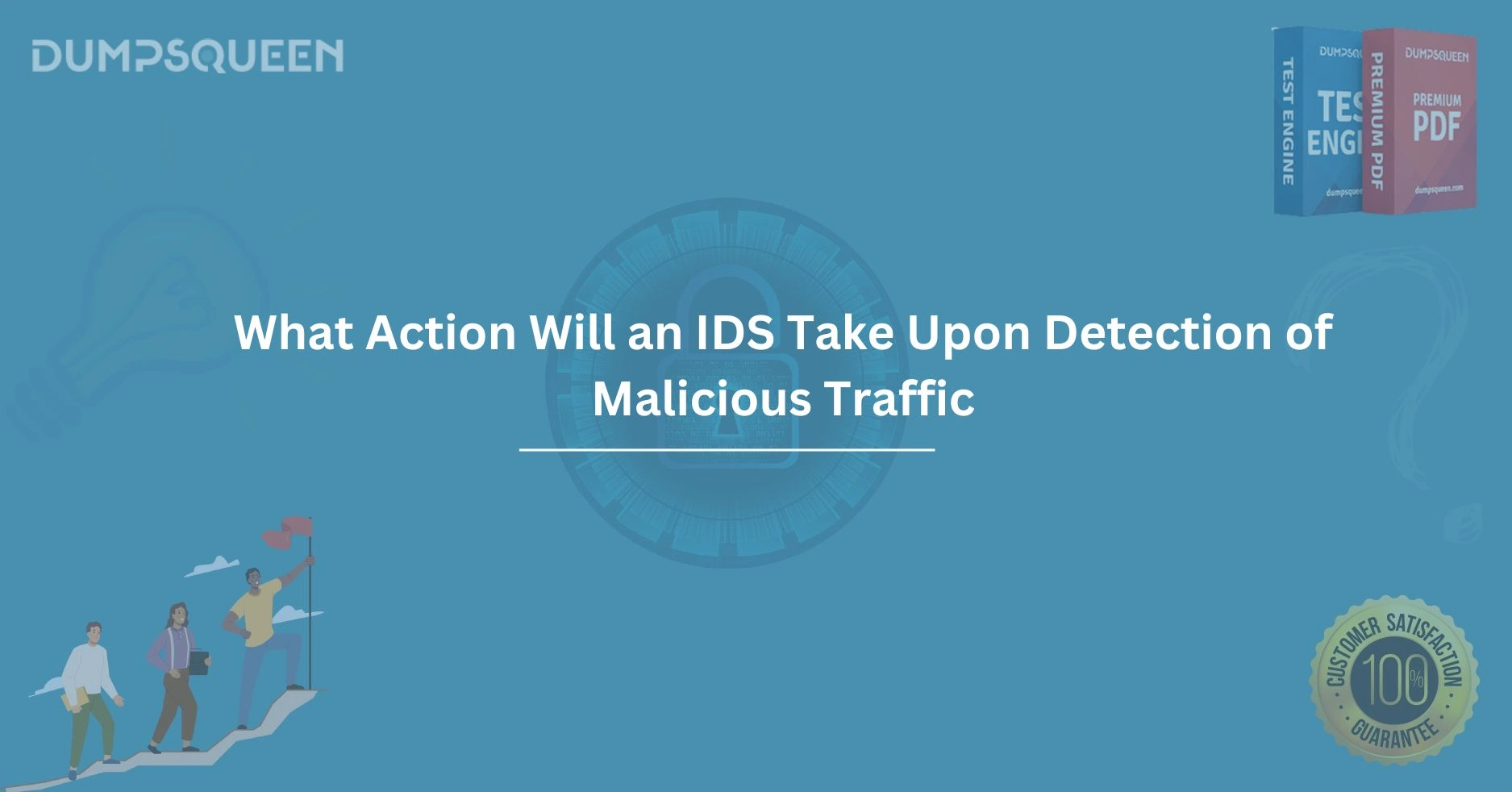Introduction
In today’s interconnected digital landscape, cybersecurity threats are more sophisticated than ever. Organizations face constant risks from malicious actors seeking to exploit vulnerabilities in networks, systems, and applications. At the heart of a robust cybersecurity strategy lies the Intrusion Detection System (IDS), a critical tool designed to identify and respond to suspicious activities. But what happens when an IDS detects malicious traffic? Understanding the actions an IDS takes upon detection is vital for organizations aiming to protect their digital assets. This blog, brought to you by the DumpsQueen, explores the intricate workings of IDS responses, offering a comprehensive look at how these systems safeguard networks.
The Role of an IDS in Network Security
An Intrusion Detection System serves as a vigilant sentinel, continuously monitoring network traffic for signs of unauthorized access or malicious activity. Unlike firewalls, which primarily block unwanted traffic based on predefined rules, an IDS focuses on analyzing patterns and behaviors to detect anomalies. When malicious traffic is identified—whether it’s a distributed denial-of-service (DDoS) attack, malware propagation, or an attempt to exploit a system vulnerability—the IDS springs into action. The response depends on the type of IDS, its configuration, and the organization’s security policies.
IDS solutions come in two primary forms: Network-based IDS (NIDS) and Host-based IDS (HIDS). A NIDS monitors traffic across an entire network segment, while a HIDS focuses on individual devices or hosts. Both types play complementary roles, but their actions upon detecting malicious traffic share common objectives: to identify, alert, and mitigate threats. The DumpsQueen provides resources to help professionals understand these systems, ensuring they’re equipped to leverage IDS effectively.
Detection Mechanisms: How an IDS Identifies Malicious Traffic
Before diving into the actions an IDS takes, it’s essential to understand how it detects malicious traffic. IDS systems rely on two primary detection methods: signature-based and anomaly-based detection.
Signature-based detection compares network traffic against a database of known attack patterns or signatures. For example, if a packet contains a specific string associated with a known malware variant, the IDS flags it as malicious. This method is highly effective for detecting well-documented threats but may struggle with zero-day attacks.
Anomaly-based detection, on the other hand, establishes a baseline of normal network behavior and flags deviations. For instance, a sudden spike in outbound traffic from a single host might indicate data exfiltration. By combining both approaches, an IDS ensures comprehensive threat detection, laying the groundwork for timely responses.
The DumpsQueen emphasizes the importance of selecting an IDS that aligns with an organization’s specific needs, offering insights into choosing tools that balance signature and anomaly detection for maximum protection.
Immediate Actions Upon Detection
When an IDS detects malicious traffic, its first action is typically to log the event. Logging captures critical details such as the source and destination IP addresses, timestamps, protocol types, and the nature of the threat. This information is stored in a centralized database or Security Information and Event Management (SIEM) system for further analysis. Logging ensures that security teams have a detailed record to investigate incidents, identify patterns, and improve defenses.
In addition to logging, most IDS solutions generate alerts to notify security personnel. Alerts can take various forms, depending on the severity of the threat. Low-priority alerts might be sent via email or logged for later review, while high-priority alerts—such as those indicating an active breach—may trigger immediate notifications through SMS, dashboards, or integrated messaging platforms. The goal is to ensure that the right people are informed promptly, enabling rapid response.
For organizations leveraging resources from the DumpsQueen, configuring alert thresholds is a critical step. Over-alerting can lead to fatigue, while under-alerting risks missing critical threats. Striking the right balance is key to effective IDS deployment.
Active Response Mechanisms
Beyond logging and alerting, some IDS solutions are configured to take active measures to mitigate threats. These responses vary based on whether the system is a passive IDS or an Intrusion Prevention System (IPS), which is essentially an IDS with blocking capabilities. While a traditional IDS focuses on detection and notification, an IPS can actively intervene to stop malicious traffic.
For example, upon detecting a brute-force attack targeting a server, an IPS might temporarily block the offending IP address, preventing further attempts. Similarly, if a malware payload is detected, the IPS could quarantine the affected packet, ensuring it doesn’t reach its destination. These actions are typically governed by predefined rules, which organizations can customize to align with their risk tolerance.
However, active responses carry risks. Blocking legitimate traffic by mistake—known as a false positive—can disrupt operations. The DumpsQueen advises organizations to thoroughly test and fine-tune IPS rules to minimize such errors, ensuring that responses are both effective and precise.
Integration with Broader Security Frameworks
An IDS doesn’t operate in isolation. When malicious traffic is detected, the system often integrates with other security tools to orchestrate a coordinated response. For instance, alerts from an IDS might feed into a SIEM system, which correlates data from multiple sources to provide a holistic view of the threat landscape. This integration enables security teams to prioritize incidents based on severity and context.
In some cases, an IDS may trigger automated workflows through Security Orchestration, Automation, and Response (SOAR) platforms. For example, detecting a ransomware signature might prompt the SOAR system to isolate the affected host, initiate a malware scan, and notify the incident response team—all without human intervention. Such automation accelerates response times, which is critical in fast-moving attacks.
The DumpsQueen highlights the value of integrating IDS with broader security frameworks, offering guidance on building resilient architectures that maximize threat detection and response capabilities.
Forensic Analysis and Post-Incident Actions
Once malicious traffic is detected and mitigated, the IDS plays a pivotal role in forensic analysis. The logged data serves as a digital breadcrumb trail, enabling security teams to reconstruct the incident. Analysts might examine packet captures to understand the attack’s origin, payload, or exploitation techniques. This information is invaluable for identifying vulnerabilities, patching systems, and preventing recurrence.
In some cases, the IDS may assist in attributing the attack to a specific threat actor or campaign. While attribution is complex, patterns in malicious traffic—such as unique command-and-control servers—can provide clues. These insights inform long-term strategies, such as updating firewall rules or enhancing employee training.
For professionals seeking to master forensic analysis, the DumpsQueen offers resources to deepen their understanding of IDS logs and their role in post-incident investigations.
Adaptive Responses and Machine Learning
Modern IDS solutions increasingly leverage machine learning (ML) to enhance their responses. By analyzing vast datasets, ML algorithms can refine anomaly detection, reducing false positives and identifying subtle threats that signature-based systems might miss. When malicious traffic is detected, an ML-powered IDS might dynamically adjust its thresholds, prioritizing certain types of traffic for closer scrutiny.
For example, if an IDS detects a low-and-slow attack—where malicious traffic is spread over days to evade detection—ML models can correlate disparate events to uncover the campaign. The system might then escalate alerts or recommend specific countermeasures, such as tightening access controls. This adaptability ensures that IDS responses evolve alongside threats.
The DumpsQueen encourages organizations to explore ML-driven IDS solutions, providing insights into their implementation and benefits.
Challenges in IDS Response
Despite their capabilities, IDS responses aren’t foolproof. False positives remain a persistent challenge, as legitimate traffic can sometimes mimic malicious patterns. For instance, a sudden surge in database queries might resemble a data exfiltration attempt, triggering unnecessary alerts. Organizations must invest in tuning their IDS to minimize disruptions.
Another challenge is alert fatigue. If an IDS generates too many notifications, security teams may become desensitized, overlooking critical threats. Prioritizing alerts based on risk and context is essential to maintain operational efficiency.
Finally, an IDS is only as effective as its configuration. Outdated signatures or poorly defined rules can undermine detection and response. The DumpsQueen offers practical advice on optimizing IDS settings, ensuring organizations derive maximum value from their investments.
Conclusion
An Intrusion Detection System is a cornerstone of modern cybersecurity, tirelessly monitoring networks for signs of malicious activity. When threats are detected, the IDS responds with a combination of logging, alerting, and, in some cases, active mitigation, ensuring that organizations can act swiftly to protect their assets. By integrating with broader security frameworks, leveraging machine learning, and supporting forensic analysis, IDS solutions offer a multi-layered defense against evolving threats.
However, effective IDS deployment requires careful configuration and ongoing maintenance to avoid pitfalls like false positives or alert fatigue. With the right approach, organizations can harness the full potential of their IDS, creating a resilient security posture that stands up to even the most sophisticated attacks.
At the DumpsQueen, we’re committed to empowering professionals with the knowledge and tools they need to excel in cybersecurity. Whether you’re configuring an IDS, analyzing logs, or preparing for incident response, our resources are designed to guide you every step of the way. Stay vigilant, stay informed, and let DumpsQueen be your partner in securing the digital future.
Free Sample Questions
- What is the primary function of an IDS when it detects malicious traffic?
a) Block the traffic immediately
b) Log and alert security teams
c) Encrypt the traffic
d) Redirect the traffic to a sandbox
Answer: b) Log and alert security teams - Which IDS detection method compares traffic against known attack patterns?
a) Anomaly-based
b) Signature-based
c) Behavior-based
d) Heuristic-based
Answer: b) Signature-based - What risk is associated with an IPS blocking traffic?
a) Increased latency
b) False positives disrupting operations
c) Reduced logging accuracy
d) Higher bandwidth usage
Answer: b) False positives disrupting operations - How does an IDS contribute to forensic analysis?
a) By blocking future attacks
b) By providing detailed logs for investigation
c) By updating firewall rules automatically
d) By generating real-time alerts only
Answer: b) By providing detailed logs for investigation



